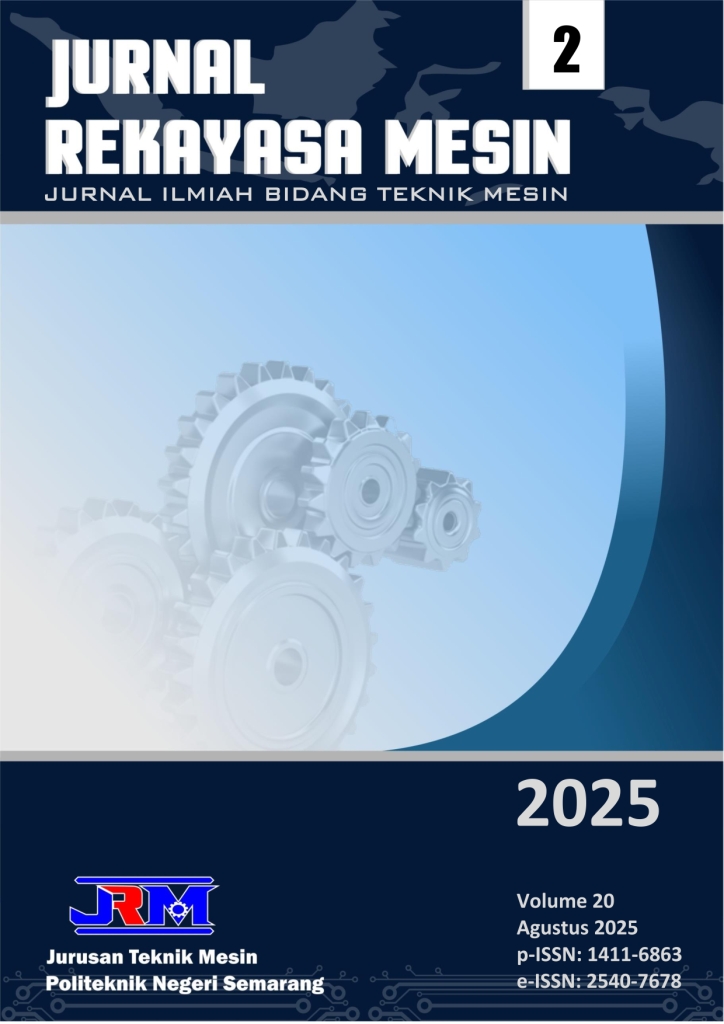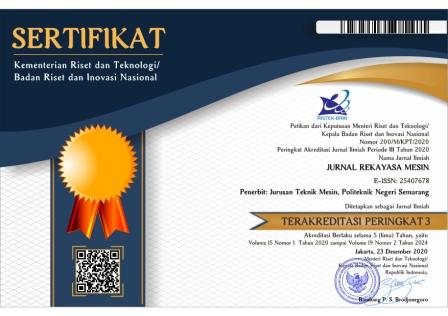Synthesis and Characterisation of Biolubricants Castor Oil (Ricinus communis L.) Using a Homogeneous Catalyst for Hydraulic Engine Applications
DOI:
https://doi.org/10.32497/jrm.v20i2.6669Keywords:
biolubricant; esterification; hydraulic; castor oil; NaOHAbstract
Lubricants are essential products that help reduce surface friction and improve machine efficiency. Lubricating oil consists of 90% base oil and 10% additives. Due to the presence of low molecular weight compounds, mineral-based lubricants exhibit a lower flash point and are not biodegradable, unlike natural oils with equivalent viscosity. Currently, mineral-based lubricants still dominate the global market, yet their environmental drawbacks and reliance on depleting petroleum resources have raised growing concerns. Although several studies have reported the potential of vegetable oils as biolubricants, challenges remain in terms of oxidative stability, viscosity control, and production scalability, which limit their widespread industrial application. The high dependence of the industrial and automotive sectors on lubricants, coupled with the depletion of petroleum reserves, drives the need to seek sustainable alternatives to support sustainable green economic development. This study aims to produce biolubricants from castor oil (Ricinus communis L.) using NaOH catalyst through an esterification method. Esterification was carried out by mixing the oil with alcohol in a molar ratio into a 250 ml three-neck flask, then heating it to 180 °C for 4 hours with 1–2% NaOH catalyst and a methanol-to-oil molar ratio of 1:4. The results showed that the highest values of kinematic viscosity, viscosity index (VI), and density were 28.9 mm²/s, 90.3, and 884.9 kg/m³, respectively. The optimum biolubricant yield was obtained with 2% catalyst (80%). The produced biolubricant met the ISO VG 32 standard, which is widely applied in hydraulic oils, for turning, drilling, and sawing processes. These findings highlight that castor oil-based biolubricants can serve as a sustainable alternative to petroleum-based lubricants; however, further research on long-term stability, wear resistance, and large-scale production remains necessary to bridge the gap towards industrial adoption.
References
[1] X. Ma, Y. Zhang, Z. Song, K. Yu, C. He, and X. Zhang, "Enzyme-catalyzed synthesis and properties of polyol ester biolubricant produced from Rhodotorula glutinis lipid," Biochemical Engineering Journal, vol. 173, p. 108101, 2021.
[2] P. Prasannakumar, S. Sankarannair, C. Bose, R. Santhakumari, and S. Jyothi, "Influence of techniques on synthesizing cashew nut shell oil as a prospective biolubricant on its physicochemical, tribological, and thermal behaviors," Journal of Cleaner Production, vol. 401, p. 136717, 2023, doi: https://doi.org/10.1016/j.jclepro.2023.136717.
[3] N. U. Callistus et al., "Optimization Of Dual Transesterification Of Jatropha Seed Oil To Biolubricant Using Hybridized Response Surface Methodology (Rsm) And Adaptive Neuro Fuzzy Inference System (Anfis)-Genetic Algorithm (Ga)," Sustainable Chemistry for the Environment, p. 100050, 2023, doi: https://doi.org/10.1016/j.scenv.2023.100050.
[4] S. Edla, A. D. Thampi, P. Prasannakumar, and S. Rani, "Evaluation of physicochemical, tribological and oxidative stability properties of chemically modified rice bran and karanja oils as viable lubricant base stocks for industrial applications," Tribology International, vol. 173, p. 107631, 2022, doi: https://doi.org/10.1016/j.triboint.2022.107631.
[5] G. Karmakar, P. Ghosh, and B. K. Sharma, "Chemically modifying vegetable oils to prepare green lubricants," Lubricants, vol. 5, no. 4, p. 44, 2017, doi: https://doi.org/10.3390/lubricants5040044.
[6] O. D. Samuel, M. O. Okwu, S. T. Amosun, T. N. Verma, and S. A. Afolalu, "Production of fatty acid ethyl esters from rubber seed oil in hydrodynamic cavitation reactor: Study of reaction parameters and some fuel properties," Industrial Crops and Products, vol. 141, p. 111658, 2019, doi: https://doi.org/10.1016/j.indcrop.2019.111658.
[7] A. N. Annisa and W. Widayat, "A review of bio-lubricant production from vegetable oils using esterification transesterification process," in MATEC Web of Conferences, 2018, vol. 156: EDP Sciences, p. 06007, doi: https://doi.org/10.1051/matecconf/201815606007.
[8] N. S. Abd Wafti, R. Yunus, H. L. N. Lau, T. S. Y. Choong, and S. Abd-Aziz, "Enzymatic synthesis of palm oil-based trimethylolpropane ester as biolubricant base stock catalyzed by Lipozyme 435," Energy, vol. 260, p. 125061, 2022, doi: https://doi.org/10.1016/j.energy.2022.125061.
[9] S. Prathiba, A. Vaishnavi, R. Saranya, C. Chandrasatheesh, and J. Jayapriya, "Synthesis of hydroxyl ether based biolubricant from poultry waste and to evaluate the friction performance with titania nanoparticles," Chemical Engineering Research and Design, vol. 185, pp. 291-300, 2022, doi: https://doi.org/10.1016/j.cherd.2022.07.020.
[10] S. Arumugam, G. Sriram, and L. Subadhra, "Synthesis, Chemical Modification and Tribological Evaluation of Plant oil as Bio-Degradable Low Temperature," doi: https://doi.org/10.1016/j.proeng.2012.06.186.
[11] U. C. Sharma and S. Sachan, "Friction and wear behavior of karanja oil derived biolubricant base oil," SN Applied Sciences, vol. 1, pp. 1-11, 2019, doi: https://doi.org/10.1007/s42452-019-0706-y.
[12] M. Habibullah, H. Masjuki, M. Kalam, M. Gulzar, A. Arslan, and R. Zahid, "Tribological characteristics of Calophyllum inophyllum–based TMP (trimethylolpropane) ester as energy-saving and biodegradable lubricant," Tribology Transactions, vol. 58, no. 6, pp. 1002-1011, 2015, doi: https://doi.org/10.1080/10402004.2015.1025934.
[13] P. Prasannakumar, S. Edla, A. D. Thampi, M. Arif, and R. Santhakumari, "A comparative study on the lubricant properties of chemically modified Calophyllum inophyllum oils for bio-lubricant applications," Journal of Cleaner Production, vol. 339, p. 130733, 2022, doi: https://doi.org/10.1016/j.jclepro.2022.130733.
[14] M. Gul et al., "Effect of TMP-based-cottonseed oil-biolubricant blends on tribological behavior of cylinder liner-piston ring combinations," Fuel, vol. 278, p. 118242, 2020, doi: https://doi.org/10.1016/j.fuel.2020.118242.
[15] R. V. Sharma, A. K. Somidi, and A. K. Dalai, "Preparation and properties evaluation of biolubricants derived from canola oil and canola biodiesel," Journal of agricultural and food chemistry, vol. 63, no. 12, pp. 3235-3242, 2015, doi: https://doi.org/10.1021/jf505825k.
[16] C.-C. Ting and C.-C. Chen, "Viscosity and working efficiency analysis of soybean oil based bio-lubricants," Measurement, vol. 44, no. 8, pp. 1337-1341, 2011, doi: https://doi.org/10.1016/j.measurement.2011.04.005.
[17] S. K. Tulashie and F. Kotoka, "The potential of castor, palm kernel, and coconut oils as biolubricant base oil via chemical modification and formulation," Thermal Science and Engineering Progress, vol. 16, p. 100480, 2020, doi: https://doi.org/10.1016/j.tsep.2020.100480.
[18] S. Pradhan, C. S. Madankar, L. Prasad, and S. Naik, "Synthesis of environmental benign biolubricant from wild castor seed by reactive extraction and optimization," Journal of the Indian Chemical Society, vol. 100, no. 2, p. 100898, 2023, doi: https://doi.org/10.1016/j.jics.2023.100898.
[19] U. Ahmad et al., "Biolubricant production from castor oil using iron oxide nanoparticles as an additive: Experimental, modelling and tribological assessment," Fuel, vol. 324, p. 124565, 2022, doi: https://doi.org/10.1016/j.fuel.2022.124565.
[20] G. Gupta, M. I. Ul Haq, A. Raina, and W. K. Shafi, "Rheological and tribological behavior of sunflower oil: Effect of chemical modification and tungsten disulfide nanoparticles," Journal of Bio-and Tribo-Corrosion, vol. 7, pp. 1-12, 2021, doi: https://doi.org/10.1007/s40735-021-00593-6.
[21] C. P. do Valle et al., "Chemical modification of Tilapia oil for biolubricant applications," Journal of Cleaner Production, vol. 191, pp. 158-166, 2018, doi: https://doi.org/10.1016/j.jclepro.2018.04.062.
[22] H. O. Yosief, M. I. Sarker, G. B. Bantchev, R. O. Dunn, and S. C. Cermak, "Chemical modification of beef tallow for lubricant application," Industrial & Engineering Chemistry Research, vol. 61, no. 27, pp. 9889-9900, 2022, doi: https://doi.org/10.1021/acs.iecr.2c01207.
[23] R. Z. Hussein, N. K. Attia, M. K. Fouad, and S. T. ElSheltawy, "Experimental investigation and process simulation of biolubricant production from waste cooking oil," Biomass and Bioenergy, vol. 144, p. 105850, 2021.
[24] I. Ilmi, S. Suherman, E. Frida, N. W. B. M. Zulkifli, and J. Jufrizal, "Mapping the landscape of WCO biolubricant studies: A Comprehensive bibliometric review with vosviewer," Mechanical Engineering for Society and Industry, vol. 4, no. 3, pp. 535-555, 2024.
[25] J. Greco-Duarte, E. Cavalcanti-Oliveira, J. Da Silva, R. Fernandez-Lafuente, and D. Freire, "Two-step enzymatic production of environmentally friendly biolubricants using castor oil: Enzyme selection and product characterization," Fuel, vol. 202, pp. 196-205, 2017.
[26] M. Hajar and F. Vahabzadeh, "Biolubricant production from castor oil in a magnetically stabilized fluidized bed reactor using lipase immobilized on Fe3O4 nanoparticles," Industrial Crops and Products, vol. 94, pp. 544-556, 2016.
[27] D. T. Nguyen et al., "Microalgae-derived biolubricants: Challenges and opportunities," Science of the Total Environment, p. 176759, 2024.
[28] M. Hadiza, S. Al-Humairi, and A. Aliyu, "Kinetics and characterization of Gmelina arborea biolubricant via two-step transesterification," Sustainable Chemistry for the Environment, p. 100240, 2025.
[29] A. A. Oliveira et al., "Design of a biolubricant by the enzymatic esterification of the free fatty acids from castor oil with neopentylglycol," Process Biochemistry, vol. 147, pp. 318-331, 2024.
[30] R. R. Monteiro et al., "Optimizing the enzymatic production of biolubricants by the Taguchi method: Esterification of the free fatty acids from castor oil with 2-ethyl-1-hexanol catalyzed by Eversa Transform 2.0," Enzyme and Microbial Technology, vol. 175, p. 110409, 2024.
[31] S. Nogales-Delgado, J. M. Encinar, and Á. G. Cortés, "High oleic safflower oil as a feedstock for stable biodiesel and biolubricant production," Industrial Crops and Products, vol. 170, p. 113701, 2021.
[32] J. Encinar, S. Nogales-Delgado, and C. Álvez-Medina, "High oleic safflower biolubricant through double transesterification with methanol and pentaerythritol: Production, characterization, and antioxidant addition," Arabian Journal of Chemistry, vol. 15, no. 5, p. 103796, 2022.
[33] B. Nurulita et al., "Novel biolubricant synthesis: Enhancing the composition of used cooking oil and Callophyllum inophyllum oil by utilizing infrared heating method," Results in Engineering, vol. 24, p. 103343, 2024.
[34] O. Ocholi, M. Menkiti, M. Auta, and I. Ezemagu, "Optimization of the operating parameters for the extractive synthesis of biolubricant from sesame seed oil via response surface methodology," Egyptian Journal of Petroleum, vol. 27, no. 3, pp. 265-275, 2018.
[35] M. D. Soufi, B. Ghobadian, S. M. Mousavi, G. Najafi, and J. Aubin, "Valorization of waste cooking oil based biodiesel for biolubricant production in a vertical pulsed column: Energy efficient process approach," Energy, vol. 189, p. 116266, 2019, doi: https://doi.org/10.1016/j.energy.2019.116266.
[36] I. C. Rios et al., "Chemical modification of castor oil fatty acids (Ricinus communis) for biolubricant applications: An alternative for Brazil’s green market," Industrial Crops and Products, vol. 145, p. 112000, 2020.
[37] N. A. Tajuddin, N. H. Rosli, N. Abdullah, M. F. Yusoff, and J. Salimon, "Estolide ester from ricinus communis L. seed oil for bio lubricant purpose," Malays. J. Anal. Sci, vol. 18, pp. 85-93, 2014.
[38] O. Feuchtmüller, L. Hörl, and F. Bauer, "Oil film generation of a hydraulic rod seal: an experimental study using ellipsometry," Tribology International, vol. 162, p. 107102, 2021.
[39] J. Salimon, B. M. Abdullah, R. M. Yusop, and N. Salih, "Synthesis, reactivity and application studies for different biolubricants," Chemistry Central Journal, vol. 8, pp. 1-11, 2014.
[40] J. Salimon, N. Salih, and E. Yousif, "Biolubricants: Raw materials, chemical modifications and environmental benefits," European journal of lipid science and technology, vol. 112, no. 5, pp. 519-530, 2010.
[41] M. Shahabuddin, H. Masjuki, and M. Kalam, "Experimental investigation into tribological characteristics of bio-lubricant formulated from Jatropha oil," Procedia Engineering, vol. 56, pp. 597-606, 2013.
[42] S. Hisham et al., "Waste cooking oil blended with the engine oil for reduction of friction and wear on piston skirt," Fuel, vol. 205, pp. 247-261, 2017, doi: https://doi.org/10.1016/j.fuel.2017.05.068.
[43] B. T. Amdebrhan, L. Damtew, D. Tesfay, H. Endris, and G. Tekeste, "Production of biolubricant from castor (Ricinus) oil," International Journal of Engineering Innovation & Research, vol. 4, no. 5, pp. 737-741, 2015.
[44] M. U Dabai, F. J Owuna, M. A Sokoto, and A. L Abubakar, "Assessment of quality parameters of ecofriendly biolubricant from waste cooking palm oil," Asian Journal of Applied Chemistry Research, vol. 1, no. 4, pp. 1-11, 2018, doi: 10.9734/AJACR/2018/v1i49691.
[45] A. Bapat, S. Pradhan, and C. S. Madankar, "Oil and Fats as Raw Materials as Corrosion Inhibitors and Biolubricants," Oils and Fats as Raw Materials for Industry, pp. 195-229, 2024, doi: https://doi.org/10.1002/9781119910558.ch.
[46] S. Arumugam, G. Sriram, and R. Ellappan, "Bio-lubricant-biodiesel combination of rapeseed oil: An experimental investigation on engine oil tribology, performance, and emissions of variable compression engine," Energy, vol. 72, pp. 618-627, 2014.
[47] G. Knothe, "Dependence of biodiesel fuel properties on the structure of fatty acid alkyl esters," Fuel processing technology, vol. 86, no. 10, pp. 1059-1070, 2005.
Downloads
Published
How to Cite
Issue
Section
License
Copyright (c) 2025 Suherman Suherman, Muharnif Muktar, Rendy Kurniawan, Ilmi Abdullah, Mawardi

This work is licensed under a Creative Commons Attribution-NonCommercial-ShareAlike 4.0 International License.
Copyright of articles that appear in Jurnal Rekayasa Mesin belongs exclusively to Penerbit Jurusan Teknik Mesin Politeknik Negeri Semarang. This copyright covers the rights to reproduce the article, including reprints, electronic reproductions, or any other reproductions of similar nature.







